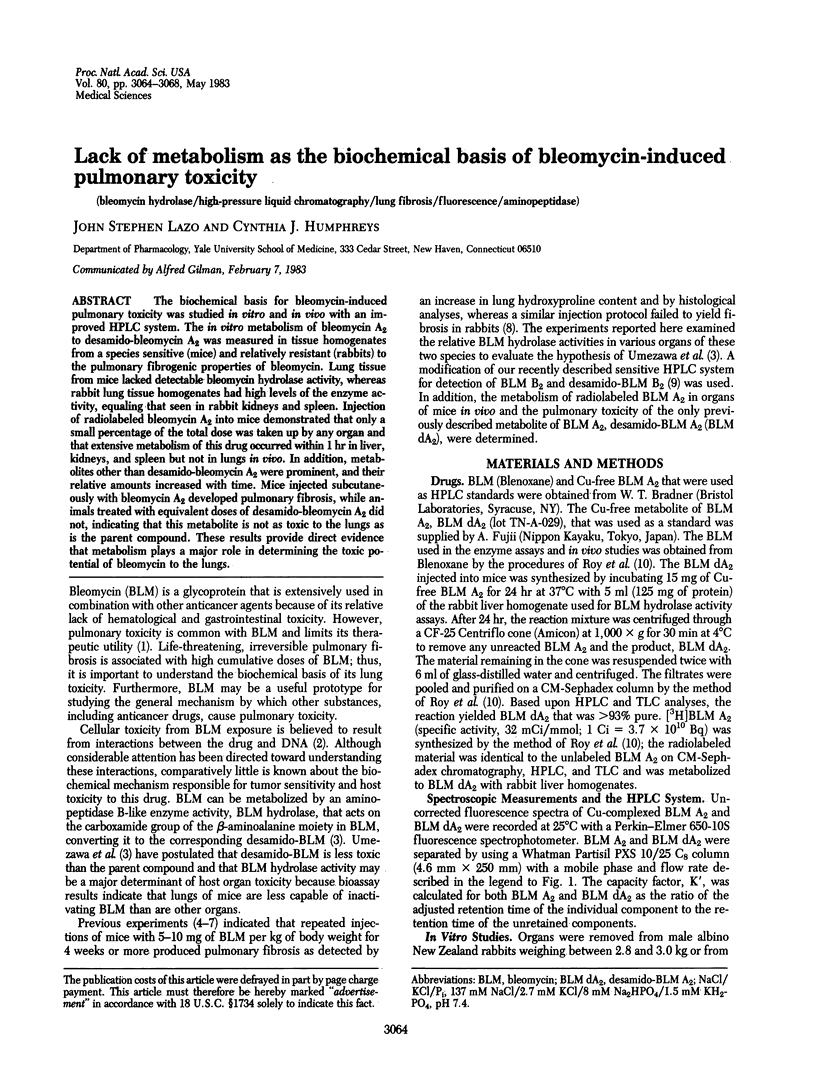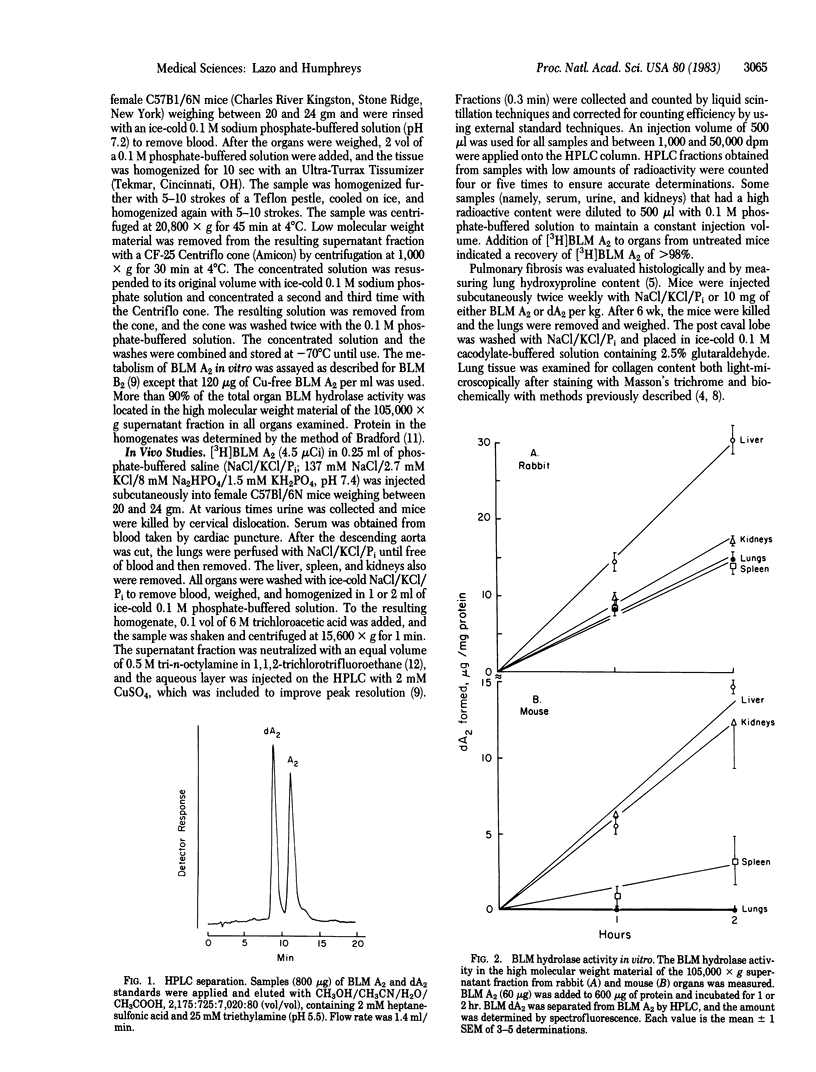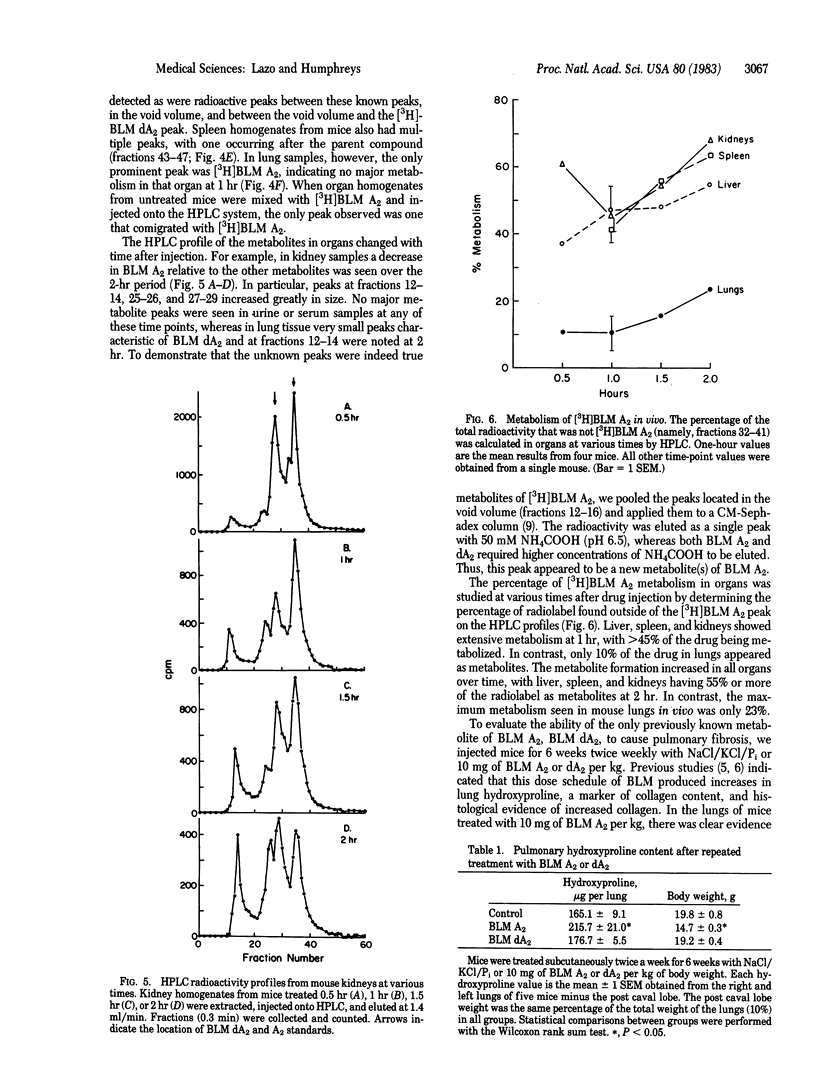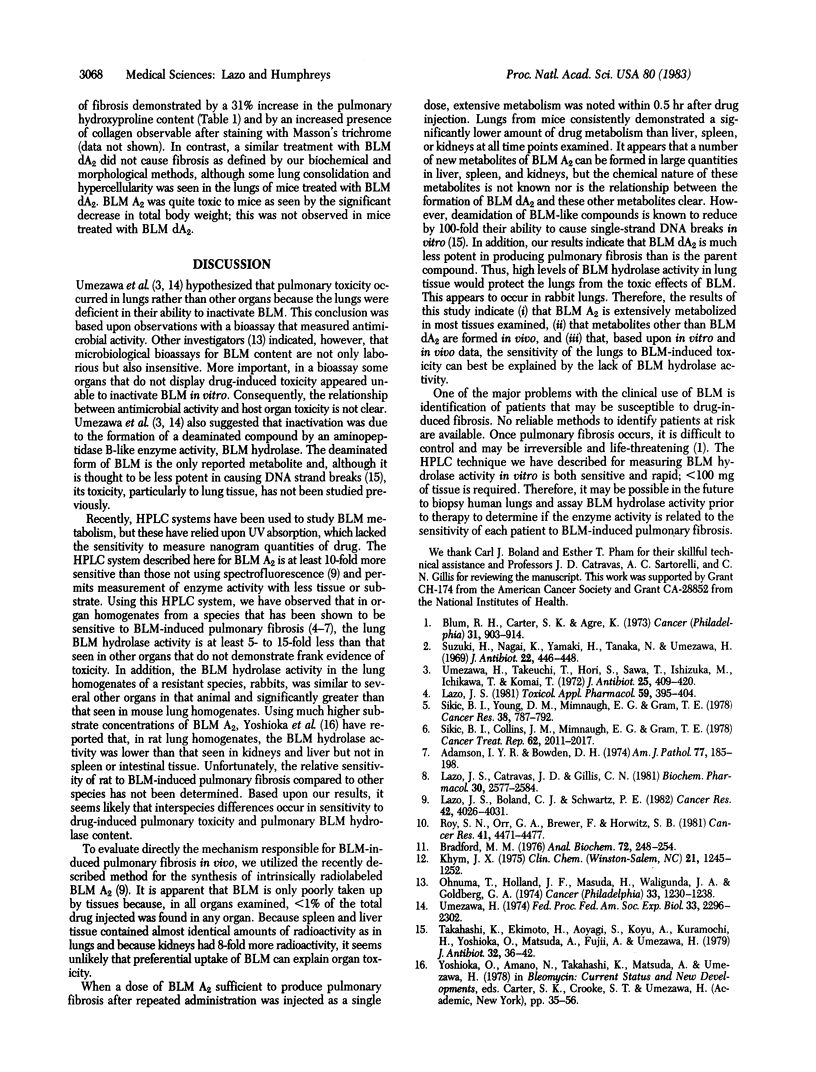Abstract
The biochemical basis for bleomycin-induced pulmonary toxicity was studied in vitro and in vivo with an improved HPLC system. The in vitro metabolism of bleomycin A2 to desamido-bleomycin A2 was measured in tissue homogenates from a species sensitive (mice) and relatively resistant (rabbits) to the pulmonary fibrogenic properties of bleomycin. Lung tissue from mice lacked detectable bleomycin hydrolase activity, whereas rabbit lung tissue homogenates had high levels of the enzyme activity, equaling that seen in rabbit kidneys and spleen. Injection of radiolabeled bleomycin A2 into mice demonstrated that only a small percentage of the total dose was taken up by any organ and that extensive metabolism of this drug occurred within 1 hr in liver, kidneys, and spleen but not in lungs in vivo. In addition, metabolites other than desamido-bleomycin A2 were prominent, and their relative amounts increased with time. Mice injected subcutaneously with bleomycin A2 developed pulmonary fibrosis, while animals treated with equivalent doses of desamido-bleomycin A2 did not, indicating that this metabolite is not as toxic to the lungs as is the parent compound. These results provide direct evidence that metabolism plays a major role in determining the toxic potential of bleomycin to the lungs.
Full text
PDF




Selected References
These references are in PubMed. This may not be the complete list of references from this article.
- Adamson I. Y., Bowden D. H. The pathogenesis of bleomycin-induced pulmonary fibrosis in mice. Am J Pathol. 1974 Nov;77(2):185–197. [PMC free article] [PubMed] [Google Scholar]
- Blum R. H., Carter S. K., Agre K. A clinical review of bleomycin--a new antineoplastic agent. Cancer. 1973 Apr;31(4):903–914. doi: 10.1002/1097-0142(197304)31:4<903::aid-cncr2820310422>3.0.co;2-n. [DOI] [PubMed] [Google Scholar]
- Bradford M. M. A rapid and sensitive method for the quantitation of microgram quantities of protein utilizing the principle of protein-dye binding. Anal Biochem. 1976 May 7;72:248–254. doi: 10.1016/0003-2697(76)90527-3. [DOI] [PubMed] [Google Scholar]
- Khym J. X. An analytical system for rapid separation of tissue nucleotides at low pressures on conventional anion exchangers. Clin Chem. 1975 Aug;21(9):1245–1252. [PubMed] [Google Scholar]
- Lazo J. S. Angiotensin converting enzyme activity in mice after subacute bleomycin administration. Toxicol Appl Pharmacol. 1981 Jun 30;59(2):395–404. doi: 10.1016/0041-008x(81)90211-8. [DOI] [PubMed] [Google Scholar]
- Lazo J. S., Boland C. J., Schwartz P. E. Bleomycin hydrolase activity and cytotoxicity in human tumors. Cancer Res. 1982 Oct;42(10):4026–4031. [PubMed] [Google Scholar]
- Lazo J. S., Catravas J. D., Gillis C. N. Reduction in rabbit serum and pulmonary angiotensin converting enzyme activity after subacute bleomycin treatment. Biochem Pharmacol. 1981 Sep 15;30(18):2577–2584. doi: 10.1016/0006-2952(81)90585-2. [DOI] [PubMed] [Google Scholar]
- Onuma T., Holland J. F., Masuda H., Waligunda J. A., Goldberg G. A. Microbiological assay of bleomycin: inactivation, tissue distribution, and clearance. Cancer. 1974 May;33(5):1230–1238. doi: 10.1002/1097-0142(197405)33:5<1230::aid-cncr2820330507>3.0.co;2-c. [DOI] [PubMed] [Google Scholar]
- Roy S. N., Orr G. A., Brewer C. F., Horwitz S. B. Chemical synthesis of radiolabeled bleomycin A2 and its binding to DNA. Cancer Res. 1981 Nov;41(11 Pt 1):4471–4477. [PubMed] [Google Scholar]
- Sikic B. I., Collins J. M., Mimnaugh E. G., Gram T. E. Improved therapeutic index of bleomycin when administered by continuous infusion in mice. Cancer Treat Rep. 1978 Dec;62(12):2011–2017. [PubMed] [Google Scholar]
- Sikic B. I., Young D. M., Mimnaugh E. G., Gram T. E. Quantification of bleomycin pulmonary toxicity in mice by changes in lung hydroxyproline content and morphometric histopathology. Cancer Res. 1978 Mar;38(3):787–792. [PubMed] [Google Scholar]
- Suzuki H., Nagai K., Yamaki H., Tanaka N., Umezawa H. On the mechanism of action of bleomycin: scission of DNA strands in vitro and in vivo. J Antibiot (Tokyo) 1969 Sep;22(9):446–448. doi: 10.7164/antibiotics.22.446. [DOI] [PubMed] [Google Scholar]
- Takahashi K., Ekimoto H., Aoyagi S., Koyu A., Kuramochi H., Yoshioka O., Matsuda A., Fujii A., Umezawa H. Biological studies on the degradation products of 3-[(S)-1'-phenylethylamino]propylaminobleomycin: a novel analog (pepleomycin). J Antibiot (Tokyo) 1979 Jan;32(1):36–42. doi: 10.7164/antibiotics.32.36. [DOI] [PubMed] [Google Scholar]
- Umezawa H. Chemistry and mechanism of action of bleomycin. Fed Proc. 1974 Nov;33(11):2296–2302. [PubMed] [Google Scholar]
- Umezawa H., Takeuchi T., Hori S., Sawa T., Ishizuka M. Studies on the mechanism of antitumor effect of bleomycin of squamous cell carcinoma. J Antibiot (Tokyo) 1972 Jul;25(7):409–420. doi: 10.7164/antibiotics.25.409. [DOI] [PubMed] [Google Scholar]


